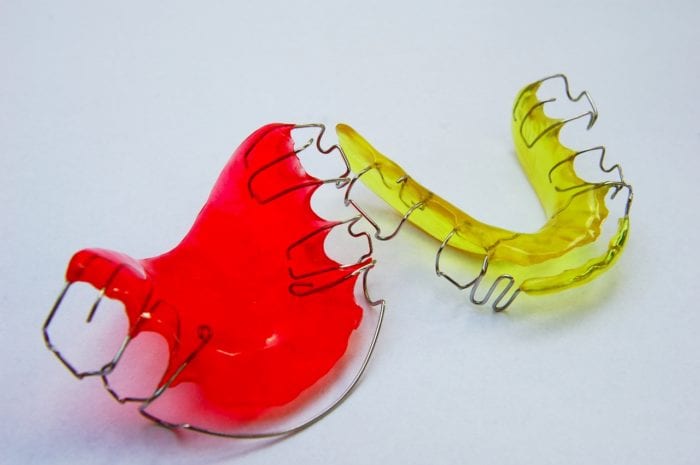Dr. Rever understands most patients’ joy when orthodontic care is complete, revealing a beautiful new smile you have been waiting to see. Straighter teeth have improved your smile’s aesthetics and overall dental health. As your Silver Spring family dentist, we want to help you keep your smile looking and feeling this way for years.
The key to maintaining the results of your orthodontic care is using a retainer as directed. We often recommend wearing your retainer every day for up to a year post-treatment.
This is to reinforce your teeth’ new position and supporting structures. Without proper retainer use, you can experience shifting of teeth due to the flexible nature of the ligaments and soft tissue that hold them in place.
After the recommended initial phase of use, most patients must wear a retainer every night. Orthodontists often advise using the retainer for the rest of your life to maintain your new tooth position.

Types Of Retainers
There are several types of retainers, and Dr. Rever will recommend the most appropriate for your needs.
- Hawley Retainer: This is the traditional style of retainer. A Hawley retainer consists of a thin layer of plastic molded to your palate and a wire over the front of the teeth. It consists of two parts: a wire and a plastic base. The wire goes around the back teeth, and the plastic base fits over the front teeth. The wire holds the teeth in place, while the plastic base keeps them from moving forward or backward.
- Clear Retainer: Similar to clear aligners, this retainer is like a mouthguard and fits snugly over the teeth. This removable appliance is ideal for both children and adults.
- Fixed Bonded Retainer: This type of retainer is for patients at a higher risk for tooth movement after treatment. Your orthodontist permanently fixes it to the back of the teeth. Only Dr. Rever can remove it when he determines you no longer need it. He may replace it with a different style of retainer.
How to Deal With Soreness
Braces are necessary for many people with crooked teeth or other dental problems. Unfortunately, braces cause a lot of soreness and discomfort. Soreness from braces is a common side effect that you can minimize with some simple tips. Here are some tips on relieving the pain and getting through the day with a little less discomfort.
- Keep your mouth closed as much as possible. This means don’t talk too much or open your mouth to yawn. If you have to speak, try to keep it short and sweet.
- Chew gum. Chewing gum can help keep your jaw moving around so that it doesn’t get stiff from being in one position for too long. It can also help alleviate some of the soreness in your jaw muscles.
- Use ice packs. Ice packs are great for relieving any swelling that you may be experiencing from wearing braces all day. Simply place an ice pack over the area where you’re feeling sore, and it should subside. This will help temporarily numb the area, reduce swelling, and decrease pain.
- Take a pain reliever. Over-the-counter pain relievers can help mitigate the soreness and discomfort in your mouth after orthodontic treatment.
It is important not to eat anything too hard, as this might worsen your soreness. It also helps to drink lots of water throughout the day so that your mouth stays hydrated and doesn’t become dry for long periods of time.
What’s The Difference Between Invisalign And Braces?
Misalignment can hurt both the health and appearance of your smile. An uneven smile can increase the risk of oral health issues, such as tooth decay, gingivitis, TMJ disorder, and bruxism (teeth grinding).
To address misalignment, you need orthodontic treatment. We offer a less visible alternative to braces with Invisalign. How does Invisalign differ from braces?
Invisalign
Treatment begins with Dr. Rever taking detailed impressions of your smile. He will use these impressions to create a series of custom-made, clear plastic aligners. Each day, the patient will wear the Invisalign aligners for between 20 and 23 hours. The patient will upgrade to a new set once every two weeks.
We usually complete treatment over a period of a year to 18 months (depending on the severity of the misalignment. Results may vary). Patients can remove the aligners before eating or when brushing and flossing their teeth. To learn more, see Invisalign.
Braces
Braces employ metal brackets connected to the front of the teeth and connected with an archwire. Using tension, the braces gradually reposition the teeth, typically over a period of 18 months to 2 years. We can use this option to address much more serious malocclusion.
However, you can not remove traditional braces during your orthodontics treatment. So be sure to avoid foods that could become stuck in them, such as hard or chewy foods. Brushing and flossing your teeth regularly before and after orthodontic treatment is important to avoid tooth decay, stain spots, and plaque.
Which is Right for Me?
Typically, Invisalign works best for patients over the age of 16 who have minor alignment issues. We can examine your smile to determine which option best addresses your misalignment. If you have questions about Invisalign, please contact our dentist office today.
